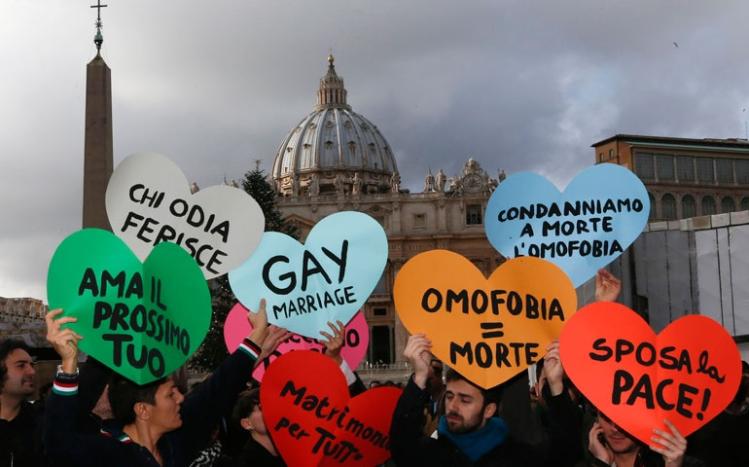
A little queer theory can be a dangerous thing. At least that’s what one might conclude after observing social conservatives eagerly citing—and in the process, badly distorting—such theory to defend traditional ideas about sexuality. A recent and striking example is Michael Hannon’s essay “Against Heterosexuality” in First Things this past March. There Hannon argues that religious conservatives should embrace queer theorists’ view that sexual orientation is a social construction, rather than a natural and inevitable feature of persons. Furthermore, they should stop categorizing anyone as gay, because doing so organizes that person’s sexual identity around a particular temptation to sin, leading him to believe that he needs that sin in order to be fulfilled. Finally, and most important, they should stop categorizing anyone as heterosexual, because doing so lets people off the hook as “normal,” thus blinding them to their own sin. The general idea is that shedding these labels will enable people better to focus on the proper Christian grounding for sex and marriage.
Hannon, who is a candidate for religious life with the Norbertine order, is hardly the first Catholic to invoke queer theory in support of conservative causes. Back in the late 1990s, when the essentialist/constructionist debate was still fresh, my old sparring partner Maggie Gallagher made a similar point at a Georgetown University conference on “Homosexuality and American Public Life.” What’s interesting about Hannon’s version is how far he goes in revealing what’s troubling social conservatives today: what they fear, what they really want, and why they’re unlikely to get it.
To understand his argument, one must reach back about two decades to an esoteric academic debate between essentialists, who argued that sexual orientation is a natural, intrinsic, and trans-historical feature of persons, and social constructionists, who countered that sexual orientation is a cultural invention, and a relatively recent one at that. The debate was confusing, especially because the disputants often seemed to be talking past each other. Moreover, as the historian John Boswell noted, virtually no one actually claimed to be an “essentialist;” that label was simply used by constructionists to critique others’ views. In any case, few scholars today would deny the constructionists’ central claim: The way modern Westerners organize sexual identity, the way we categorize ourselves and others—gay, straight, and bisexual—is not universal. Those categories did not gain social salience until the late nineteenth century.
This claim is easily misunderstood. To say that these categories lacked social salience prior to the nineteenth century is not to say that there weren’t people who engaged in, and predominantly favored, romantic relationships with persons of the same sex. Of course there were. Nor is it to say that they and others didn’t recognize that some people had such preferences. Of course they did. (Aristophanes’ myth in Plato’s Symposium is often cited as evidence.) Nor is it to deny that their preference for the same sex might be strongly genetically influenced. One of the reasons the essentialist/constructionist debate proved so confusing is that it was often conflated with the nature/nurture debate that was raging simultaneously: Are people born gay (or straight, or bisexual), or are they made so through family or social influences? Those debates actually address distinct questions—essentialist/constructionist is about identity categories, whereas nature/nurture is about the etiology of sexual desire—but it’s easy to oversimplify them in such a way that makes them look more connected than they are.
An analogy may help (this one from the philosopher and legal theorist Edward Stein): Some people strongly prefer to sleep on their backs, others on their stomachs. Perhaps these preferences are genetically based, perhaps not. Perhaps they’re changeable; perhaps not. But the point is that no one divides the world into “backers” and “fronters” or grants such categories any social significance. According to the social constructionists, the common categories of sexual orientation (gay, straight, bisexual) used to be that way, too.
THUS FAR I'VE been describing social constructionism as a view about identity, not etiology. There’s another, more controversial version, however. It’s the one that’s easily caricatured as “Society makes people gay,” which of course made it a perfect foil in the 1990s for equally simplistic “gay genes” talk. But there’s a more plausible rendering, and it goes something like this: Human sexual desires don’t appear fully formed. Our early intimations of them are often amorphous and inarticulate. And social environment, especially during puberty, can shape and change them—not only providing pathways for expression but also refining them in the process. That is a view about etiology, or at least, about one significant element of a full etiological picture.
Whether this view is correct is an empirical question, and one that’s difficult to test. (One way would be to drop genetically identical humans into various cultures and historical periods, and see how their specific desires turn out. Obviously, this is not feasible.) But its account of desire-shaping is at least plausible. It certainly coheres with my own experience: When I was eight or nine, I used to get a funny, animated feeling watching the boy next door mow the lawn. Did I sexually desire him? Not really, no. I certainly didn’t desire to have sex with him, or even to kiss him: I just felt a kind of amorphous excitement in his presence. It wasn’t until much later that I could retroactively characterize that excitement as a “gay feeling” and the person experiencing it (me) as a “gay person.” Now when I’m in the presence of a handsome guy, my desires are much more specific. What the “etiological” social constructionists are saying is that the experiences I had in the interim helped to form those desires. They did not merely give me the terminology for them—although that fact is important, too. They shaped their contours.
Which begins to explain what’s worrying right-wing folks like Hannon, to the point where some of them are desperately grasping at left-wing academic theory. Today more than ever, young people see gay life and gay sex and gay relationships as possible options. Gay-rights advocates (myself included) have worked hard to ensure this, from the It Gets Better Project to the marriage-equality movement to college football star Michael Sam’s coming out. What we advocates want is for these young people to have plausible pathways for a healthy, fulfilling adult gay life. We want them to know that they’re not alone. The problem is that what we want is precisely what social conservatives fear. To put the point simply: They’re worried that we’re making their kids gay.
Making them gay, how? Not in the obviously silly sense that we’re causing otherwise straight kids to switch teams. (After all, the usual response to a gay person is not, “No fair! How come he gets to be gay?”) But rather in the sense that the boy who gets that funny feeling around the boy next door will find pathways that shape that feeling into something more specific. He’ll begin to see gay life and gay sex and gay relationships as live options. He’ll grow up to be an Active Homosexual.
Under the old regime, things might have been different. (Keep in mind that the sans-category regime Hannon longs for is over a hundred years gone, although vestiges of it linger, especially in certain cultures.) Under the old regime, that boy might have grown up to marry a woman, for example, and had a not-passionate but still adequate marriage. Sure, he’d continue to get that funny feeling around guys, but it might not be a recognizably gay feeling, let alone a fully formed desire for gay sex.
Or he might have grown up to be a priest. That was my plan, actually. I entered a religious order at nineteen. It was there during formation retreats that I met other openly gay people for the first time: fellow candidates, brothers, and priests. By then I knew enough about the world that those funny feelings had morphed into recognizably gay feelings, and yet I still emphatically and sincerely believed I was not gay. Of course, I knew that I lacked “straight feelings,” and I knew at least implicitly that a person with gay feelings but no straight feelings is gay. (This, from someone who would later teach elementary logic.) Somehow, by not letting certain ideas in my head touch each other, I could refuse to draw the obvious conclusion from them.
At least, I could refuse to do so until I met these other people who were doing so. My openly gay friends in the order let me know that gay life and gay sex and gay relationships were possible, and so I left to explore those options. Hannon would be horrified, and perhaps the local bishop would have been too, but my spiritual director practically sang “Climb Ev'ry Mountain” as I walked out the friary door.
The new regime, which allows for such alternatives, strikes many of us as a very good thing. It’s not because we believe that desire-satisfaction is always good. Sexual desires in particular can powerfully incline people to favor short-term pleasure over long-term welfare, as Christian moral teaching has long and properly noticed. It’s rather because we recognize that a small but significant portion of our fellow human beings are predominantly attracted to persons of the same sex, and that previous generations’ tendency to ignore or hide or stifle this fact did far more harm than good. It’s because we believe that romantic love is a good thing, and (more controversially) that the sexual expression of that love can bear good fruit even in relationships where procreation is neither intended nor possible. It’s because the categories of sexual orientation were, are, and will continue to be useful.
For some of us, it’s not that difficult to imagine life without such categories. For my generation (mid-40s) and older, that was the experience of our childhood—by which I mean that it was the only world of which we were aware. Our parents and teachers and pastors made sure that we were sheltered from “those people,” our television shows kept them hidden, our books were censored. To the extent that we learned about such topics at all, it was as something distant and pathological: surely nothing that applied to us kids. The result? Confusion, isolation, loneliness, fear; the sense that “I must be the only one.” We may not have understood our funny feelings, but we knew enough to keep quiet about them. It was an ugly, painful time.
To be clear: Hannon is not asking for a return to the 1950s, when the categories of sexual orientation were available but hidden. He’s asking for something much more difficult for us moderns to imagine: a world without sexual orientation as we understand it. Yet it’s hard to see how to avoid the closet as a necessary first step toward this goal. Worse, one worries that aiming for this goal would at most achieve a disastrous middle ground: a world where orientation categories were still salient but where the taboo against voicing them would leave those with same-sex desires lonely and miserable.
WHICH BRINGS ME BACK to Hannon’s essay, which is by turns incisive, naïve, and scary. It’s incisive, because Hannon recognizes how having gayness available as a social category makes it more likely that people will develop—and want to satisfy—full-fledged gay sexual desires. This is not your father’s homophobia (“They’re trying to recruit your children!”) but a subtle argument about etiology and identity.
Yet Hannon’s essay is also naïve, displaying the most superficial grasp of what social constructionists actually believe. For example, he assumes throughout his essay that because sexual orientation is being socially constructed, that means it can be intentionally (if not easily) unconstructed. Queer theorists, he says, want to “make, unmake, and remake their sexuality as they see fit.”
Actually, no. For one thing, queer theorists are theorists, and many are more concerned with understanding sexuality than with changing it. (Also, it’s worth noting that they would be horrified at Hannon’s narrow and rigid prescriptions for change.) More important, they also have a lot more common sense than Hannon attributes to them. Here’s the prominent queer theorist David Halperin:
Just because my sexuality is an artifact of social processes doesn’t mean I’m not stuck with it. Particular cultures are contingent, but the personal identities and forms of erotic life that take place within the horizons of those cultures are not. To say that sexuality is learned is not to say that it can be unlearned—any more than to say that ‘culture changes’ is to say that it’s malleable.
Halperin’s point is primarily directed toward reparative therapists and other “change is possible” types who think gayness can be cured, and the point is worth underscoring: Social constructionists are not claiming that sexual orientation is a “choice,” in the sense of something that individuals, or their therapists or pastors, can substantially control. But he’s also warning against hubris in the face of powerful cultural forces. Hannon writes that sexual orientation is “nothing more than a fragile social construct.” One might just as well argue that language, government, and religion are nothing more than fragile social constructs, albeit ones with longer histories. Gender too. Even biological sex, if you take the more radical queer theorists seriously. One of the oddest points of Hannon’s essay comes when he claims that “Of course, we do have a model norm for the evaluation of sexual deviancy,” and the reader expects him to reference the Genesis creation account, where God creates humankind male and female. Instead, Hannon tells us that the model is “Christ Jesus himself”—a single, celibate man. Perhaps he’s up for more dismantling than we think.
Please do not misunderstand my position. I’m not arguing that Hannon shouldn’t use queer theory because queer theorists would disagree with his conclusions. Rather, I’m arguing that he badly misunderstands the theory’s details, commitments, and logical entailments. Moreover, although I find etiological social constructionism plausible, I don’t think it’s possible to intentionally reduce the number of gays by social engineering. (Neither does Halperin, apparently.) For one thing, social environment is a complex web whose workings are often beyond our grasp. For another, there’s no putting the toothpaste back in the tube: Unless Hannon manages to burn down the libraries and obliterate the internet and silence vast portions of the population, young kids with inchoate gay feelings will eventually discover that gay identity, along with the sense of community it provides, is available to them.
Finally, and most important, while etiological social constructionism may be plausible for full-fledged, detailed sexual desires, I don’t think it’s plausible for sexuality’s basic building blocks, given the substantial evidence for genetic and epi-genetic contributions to sexual orientation. Thus, attempting to prevent gayness via social change won’t produce fewer gay people; it will just produce more who are closeted, unhappy, and frustrated.
Even more naïve than Hannon’s view that we can eliminate sexual-orientation categories is his claim that we will—indeed, it will happen within our lifetimes. “Mark my words,” he confidently announces, “The queer theorists will have their way in dismantling the thing before long.” That’s in part because they’re “increasingly calling the shots at the elite level.”
That last one gave us a good laugh at Gay Headquarters, let me tell you. Keep in mind that, to the extent that queer theorists have advocated a political agenda (apart from AIDS activism, where their contributions were significant), it has been in opposition to marriage. In particular, they’ve argued that gays should avoid assimilating to such a coercive, conservative institution. We all know how that’s going.
Such howlers aside, there’s nothing funny about the Hannon piece—indeed, it’s scary. For Hannon makes clear exactly what these social conservatives ultimately want. It’s not merely to deny same-sex couples the freedom to marry. It’s not merely to refuse to do our wedding photography or to bake our cakes. It’s not even merely to push gay-identified people back into the closet, although that’s an essential—and sufficiently frightening—first step in Hannon’s dismantling fantasy.
What they want is nothing less than to dismantle the very vocabulary by which we express and realize our inchoate longings for intimacy. They want to push us back to a time when homosexuality was not merely the “love that dare not speak its name,” but the love that could not speak it. They want to restore a regime where the boy with the funny feeling might—if he’s lucky—grow up to have a good-enough heterosexual marriage, but he might just as easily grow up to have a lonely life of furtive, dangerous same-sex encounters.
The old regime died because it was cruel and inhumane. Hannon seems to hope that, by not naming our reality, he can make it go away. He’s badly wrong about that, and thankfully so.
Please email comments to [email protected] and join the conversation on our Facebook page.
Share
Previous Story
George Eliot, Thomas a Kempis, and Christian Wiman
Next Story
Is there a Christian Left?


